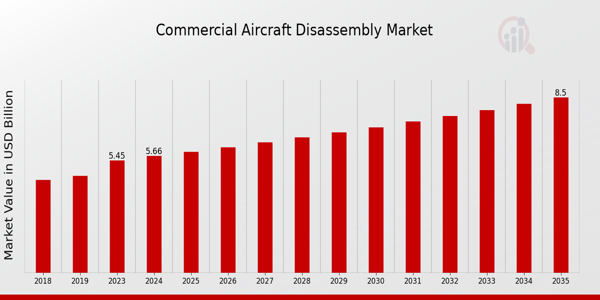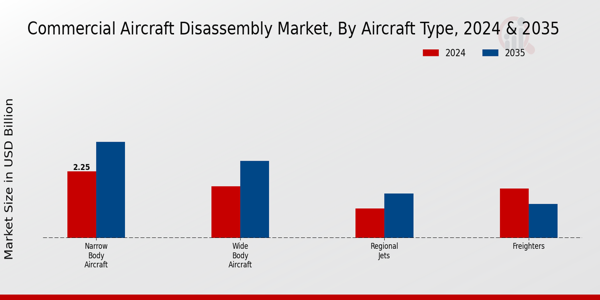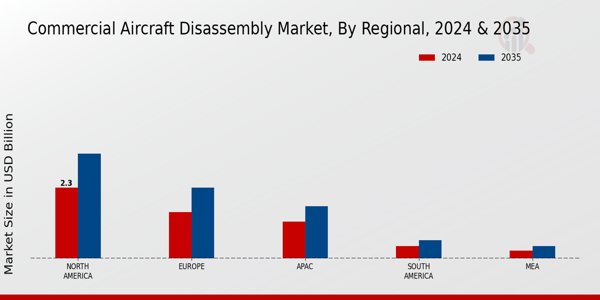Commercial Aircraft Disassembly Market Overview
Commercial Aircraft Disassembly Market Size was estimated at 5.45 (USD Billion) in 2023.The Commercial Aircraft Disassembly Market is expected to grow from 5.66(USD Billion) in 2024 to 8.5 (USD Billion) by 2035. The Commercial Aircraft Disassembly Market CAGR (growth rate) is expected to be around 3.77% during the forecast period (2025 - 2035).

Source: Primary Research, Secondary Research, MRFR Database and Analyst Review
Key Commercial Aircraft Disassembly Market Trends Highlighted
A number of significant market factors are propelling the noteworthy expansion of the global commercial aircraft disassembly market. Airlines and manufacturers are being forced to look for effective solutions to get rid of decommissioned airplanes due to growing rules surrounding sustainability and trash management.
Businesses are investing in disassembly and recycling activities as a result of this emphasis on environmental responsibility. Additionally, airplane parts recovery is a desirable alternative due to the growing cost of raw materials, which allows businesses to make more money.
As airlines search for cost-effective ways to maintain operational efficiency while managing aging fleets, the market is also being driven by the need for affordable maintenance and replacement parts.
Several opportunities exist within this market that can be explored or captured by industry players. The development of advanced technologies, such as automated disassembly processes and innovative recycling methods, offers a pathway to enhance efficiency and profitability.
Companies can capitalize on the rising demand for refurbished aircraft components and materials, which provide an affordable alternative to new parts.
Furthermore, partnerships with airlines for long-term disassembly agreements can create a steady revenue stream. Expanding capabilities to include the disassembly of diverse aircraft types can also open new market segments and enhance competitiveness.
Trends in recent times reflect a growing interest in the circular economy, where recovering materials and reusing components is becoming a priority. There is also an increased emphasis on transparency and traceability in the supply chain, enabling consumers to make informed choices regarding aircraft parts.
As airlines and manufacturers look to modernize their fleets, the integration of data analytics and digital tools within the disassembly process is emerging as a significant trend, allowing for better inventory management and forecasting. These trends highlight a shift towards more sustainable practices and innovative solutions within the commercial aircraft disassembly landscape.
Commercial Aircraft Disassembly Market Drivers
Increasing Fleet Size of Commercial Aircraft
The Global Commercial Aircraft Disassembly Market is experiencing growth largely due to the continuous increase in the fleet size of commercial aircraft worldwide. Airlines are expanding their operations to meet rising passenger demand, which necessitates the procurement of new aircraft.
As older aircraft reach the end of their service life, disassembly becomes essential for recycling valuable components and materials. This process not only aids in the sustainable management of aircraft end-of-life but also contributes to the circular economy principles being adopted by the aviation industry.
With airlines focusing on fleet renewal and environmental sustainability, the activity surrounding disassembly of outdated aircraft is expected to increase. The rising costs of maintaining older aircraft combined with stringent environmental regulations further encourage airlines to retire aging fleets and engage in disassembly.
Thus, the interplay of expanding airline services and the lifecycle management of existing fleets is a significant driver of the Global Commercial Aircraft Disassembly Market.
Regulatory Compliance and Environmental Concerns
Growing regulatory pressures aimed at minimizing the environmental footprint of aviation are significantly transforming the Global Commercial Aircraft Disassembly Market. As governments introduce more stringent regulations for aircraft disposal, the need for compliant aircraft disassembly services has become crucial.
This regulatory environment compels airlines to pursue eco-friendly practices, pushing them to recycle components and materials during disassembly rather than simply scrapping obsolete aircraft. Consequently, companies specializing in disassembly technologies are in high demand, driving market growth.
Technological Advancements in Disassembly Processes
The advancement of technologies related to the disassembly of commercial aircraft is significantly propelling the Global Commercial Aircraft Disassembly Market. New techniques, including automated disassembly and improved component recovery processes, enable faster and more efficient disassembly operations.
These innovations not only reduce labor costs but also enhance the recovery rates of various materials, including metals, composites, and electronic components. As this technology continues to evolve, it is likely to attract more players to the market, thereby increasing overall capacity and efficiency in aircraft disassembly operations.
Commercial Aircraft Disassembly Market Segment Insights:
Commercial Aircraft Disassembly Market Aircraft Type Insights
The Global Commercial Aircraft Disassembly Market witnessed a robust growth trajectory, particularly in the category defined by Aircraft Type. Within this broad category, the segmentation revealed distinct valuations that underline the varying demand and the importance of each aircraft type in the disassembly landscape.
The Narrow Body Aircraft segment led this segmentation, commanding a significant market share with an estimated value of 2.25 USD Billion in 2024, and is expected to grow to 3.25 USD Billion by 2035.
This dominance can largely be attributed to the higher volume of narrow body aircraft in commercial aviation, facilitating more consistent disassembly operations as these aircraft reach the end of their operational lives.
Following closely, Wide Body Aircraft generated considerable revenue, valued at 1.75 USD Billion in 2024, with a projection of 2.6 USD Billion by 2035. Their long-haul capabilities and associated maintenance demands make them significant players in the disassembly market.
Regional Jets contributed to this segment as well, holding a value of 1.0 USD Billion in 2024, and expected to rise to 1.5 USD Billion by 2035. While they represented a smaller share of the overall market, their increasing utilization in regional air travel drove the necessity for disassembly solutions as these aircraft retire.
Furthermore, Freighters contributed a value of 1.66 USD Billion in 2024, although a decline to 1.15 USD Billion by 2035 is forecasted. This reflected the shifting trends in air cargo logistics and the aging fleets of freighter aircraft, highlighting a market cycle influenced heavily by both demand and the structural changes in cargo transport.
The Global Commercial Aircraft Disassembly Market segmentation indicated a landscape where Narrow Body Aircraft notably leads due to its significant volume and turnover in the aviation industry. The ample availability of these aircraft for disassembly, in conjunction with the emphasis on recycling and sustainability, is expected to drive further growth in this segment.
Additionally, the Wide Body Aircraft segment's solid performance emphasized the importance of these aircraft in long-haul routes, thus anchoring a substantial share of disassembly activity.
As the commercial aviation sector continues to expand, especially in developing regions, the demand for efficient disassembly solutions will likely enhance opportunities, countered by challenges such as compliance with environmental regulations and managing the end-of-life processes for these aircraft types.
Overall, the dynamics within the Global Commercial Aircraft Disassembly Market were shaped intricately by aircraft type, with each segment contributing uniquely to the market's valuation and potential for future growth. The diverse needs across the aircraft segments necessitated tailored strategies for the disassembly process, enhancing market competitiveness and operational efficiency across the board.

Source: Primary Research, Secondary Research, MRFR Database and Analyst Review
Commercial Aircraft Disassembly Market Disassembly Process Insights
The Global Commercial Aircraft Disassembly Market, particularly within the Disassembly Process segment, is set to experience robust growth. This market consists of three main types: Manual Disassembly, Automated Disassembly, and Hybrid Disassembly.
Manual Disassembly remains crucial due to its flexibility and the skilled labor required, allowing for detailed inspections and evaluations. Automated Disassembly is gaining traction as technological advancements enhance efficiency and safety, ultimately reducing labor costs.
Meanwhile, Hybrid Disassembly combines the advantages of both manual and automated processes, offering flexibility while maximizing productivity. The adoption of these processes is driven by increasing regulatory pressures, the need for sustainable practices, and the demand for recyclable materials from decommissioned aircraft.
As the market continues to grow, the integration of innovative technologies and automated solutions is expected to create significant opportunities while posing challenges in workforce training and adaptation to new systems.
Overall, the Global Commercial Aircraft Disassembly Market is evolving to accommodate diverse needs and approaches, paving the way for increased operational efficiency and environmental responsibility.
Commercial Aircraft Disassembly Market Material Type Insights
Among these, aluminum plays a prominent role due to its lightweight and strong properties, offering significant advantages during disassembly operations.
Composite materials have gained traction as well, providing enhanced durability and fuel efficiency, thus becoming increasingly important in today's aircraft manufacturing. Steel and titanium, though used less frequently, are still critical due to their durability and strength, especially in structural components.
The segmentation within the Global Commercial Aircraft Disassembly Market highlights the shift towards lightweight materials which not only reduce operational costs but also contribute to sustainability efforts by allowing for more efficient recycling processes.
As the industry continues to evolve, understanding these material types and their impact on market dynamics will be integral for stakeholders aiming to optimize disassembly protocols and enhance recovery rates.
The increasing focus on environmental sustainability and regulatory pressures also create opportunities for innovation within the material types category, driving advancements in disassembly practices.
Commercial Aircraft Disassembly Market End of Life Management Insights
The End of Life Management segment within the Global Commercial Aircraft Disassembly Market plays a crucial role in ensuring efficient and sustainable disposal of retired aircraft.
Recycling in this context is essential, as it allows for the repurposing of valuable materials, reducing environmental impact while addressing resource scarcity. Parts reclamation also holds a significant position, with valuable aircraft components being refurbished and reused, which not only minimizes waste but also lowers costs for operators.
Waste disposal encompasses the safe and responsible disposal of unusable aircraft parts and materials, complying with regulations and promoting environmental safety.
The combined efforts in these areas represent a vital approach towards maintaining sustainability in the aviation industry, reflecting the increasing awareness of ecological concerns and the necessity for responsible management of aircraft end-of-life processes.
The growing attention on this segment is driven by regulatory pressures and industry shifts towards sustainable practices, presenting both challenges and opportunities for stakeholders in the Global Commercial Aircraft Disassembly Market.
Commercial Aircraft Disassembly Market Regional Insights
The Global Commercial Aircraft Disassembly Market exhibited notable regional dynamics, with North America holding the majority, valued at 2.3 USD Billion in 2024 and projected to grow to 3.4 USD Billion by 2035. This region's dominance can be attributed to the presence of major aircraft manufacturers and a well-established supply chain supporting disassembly processes.
Europe followed with a valuation of 1.5 USD Billion in 2024, projected to reach 2.3 USD Billion by 2035, showcasing the region's significant investment in aircraft lifecycle management. The APAC market, valued at 1.2 USD Billion in 2024 and expected to grow to 1.7 USD Billion by 2035, reflected increasing air travel demand, incentivizing disassembly activities.
South America, with a smaller share at 0.4 USD Billion in 2024 growing to 0.6 USD Billion by 2035, indicated potential for growth driven by airport expansions and regional air traffic increase. MEA's market was valued at 0.26 USD Billion in 2024, anticipated to reach 0.4 USD Billion by 2035, representing an emerging opportunity region with rising aircraft operations and maintenance needs.
Overall, market growth was propelled by rising air travel, environmental sustainability initiatives, and the need for effective aircraft lifecycle management.

Source: Primary Research, Secondary Research, MRFR Database and Analyst Review
Commercial Aircraft Disassembly Market Key Players and Competitive Insights:
The Global Commercial Aircraft Disassembly Market is experiencing significant evolution due to various factors including advancements in technology, regulatory requirements, and an increased emphasis on sustainability in the aviation sector.
Competition within this market has grown as companies vie for dominance in disassembly services, which are vital for aircraft retirement and recycling processes. Key players are continuously enhancing their processes and service offerings to differentiate themselves from rivals.
As the demand for decommissioned aircraft recycling rises, organizations are focusing on innovative solutions and operational efficiencies to create a sustainable future in aviation. This competitive landscape is defined by the players' ability to adapt to changing market dynamics while maintaining compliance with stringent environmental standards that govern disassembly and recycling efforts.
Aviation Partners stands out in the Global Commercial Aircraft Disassembly Market with its extensive experience and specialized knowledge in aircraft decommissioning. The company is recognized for its advanced techniques and efficient methodologies that ensure safe and thorough disassembly of aircraft.
Its commitment to environmentally friendly practices and recycling initiatives contributes to its competitive edge, making it a preferred choice for various stakeholders in the aviation industry.
Aviation Partners leverages its strong relationships with airlines and aviation companies, which enables it to secure a consistent inflow of projects. The company’s operational excellence, coupled with its dedication to customer satisfaction, positions it favorably against its competitors, allowing it to thrive in a market marked by both opportunities and challenges.
Girling Aerotech has established itself as a credible player in the Global Commercial Aircraft Disassembly Market through its comprehensive service offerings and commitment to quality. The company focuses on providing a range of disassembly solutions tailored to meet diverse client needs, allowing it to tap into various segments within the industry.
Girling Aerotech is known for its innovative approach to disassembly processes, which enhances safety and efficiency, thereby attracting a loyal customer base. The integration of state-of-the-art technologies into its operations not only improves turnaround times but also demonstrates the company’s commitment to maintaining high standards.
Their strategic positioning within the market, along with a strong emphasis on operational integrity, enables Girling Aerotech to effectively compete with other major players in the ever-evolving landscape of aircraft disassembly.
Key Companies in the Commercial Aircraft Disassembly Market Include:
- Aviation Partners
- Girling Aerotech
- AeroParts
- AeroCentury
- CAVU Aerospace
- AerSale
- Clyde Aviation
- XTI Aircraft Company
- Air Salvage International
- AeroIncome
- STS Aviation Group
- Aircraft Demolition
Commercial Aircraft Disassembly Market Developments
Recent developments in the Global Commercial Aircraft Disassembly Market point towards increased activity amid growing demand for sustainable aviation practices. Companies like CAVU Aerospace and AerSale have made strides in enhancing their disassembly processes, focusing on maximizing component recovery to support greener practices.
Furthermore, AeroCentury recently expanded its inventory of aircraft parts, enhancing its position in the market. In terms of mergers and acquisitions, Girling Aerotech has gained prominence through strategic alliances to broaden its service offerings, while Aviation Partners actively explores synergies to strengthen its operational capabilities.
The market has witnessed a notable uptick in valuations as airlines seek efficient ways to retire aging fleets, driving demand for dismantling services.
As a result, companies such as Aircraft Demolition and STS Aviation Group have reported significant growth, reflecting the sector’s resilience and evolution in a rapidly changing economic environment, with an increased focus on recycling and material recovery, prompting industry players to innovate and adapt accordingly.
The collaboration among major players is evident, with increased refinement in disassembly practices that cater to a more environmentally conscious landscape, positioning the market for further growth.
Commercial Aircraft Disassembly Market Segmentation Insights
Commercial Aircraft Disassembly MarketAircraft TypeOutlook
- Narrow Body Aircraft
- Wide Body Aircraft
- Regional Jets
- Freighters
Commercial Aircraft Disassembly MarketDisassembly ProcessOutlook
- Manual Disassembly
- Automated Disassembly
- Hybrid Disassembly
Commercial Aircraft Disassembly MarketMaterial TypeOutlook
- Aluminum
- Composite Materials
- Titanium
- Steel
Commercial Aircraft Disassembly MarketEnd of Life ManagementOutlook
- Recycling
- Parts Reclamation
- Waste Disposal
Commercial Aircraft Disassembly MarketRegionalOutlook
- North America
- Europe
- South America
- Asia Pacific
- Middle East and Africa
|
Report Attribute/Metric
|
Details
|
|
Market Size 2023
|
5.45(USD Billion)
|
|
Market Size 2024
|
5.66(USD Billion)
|
|
Market Size 2035
|
8.5(USD Billion)
|
|
Compound Annual Growth Rate (CAGR)
|
3.77% (2025 - 2035)
|
|
Report Coverage
|
Revenue Forecast, Competitive Landscape, Growth Factors, and Trends
|
|
Base Year
|
2024
|
|
Market Forecast Period
|
2025 - 2035
|
|
Historical Data
|
2019 - 2024
|
|
Market Forecast Units
|
USD Billion
|
|
Key Companies Profiled
|
Aviation Partners, Girling Aerotech, AeroParts, AeroCentury, CAVU Aerospace, AerSale, Clyde Aviation, XTI Aircraft Company, Air Salvage International, AeroIncome, STS Aviation Group, Aircraft Demolition
|
|
Segments Covered
|
Aircraft Type, Disassembly Process, Material Type, End of Life Management, Regional
|
|
Key Market Opportunities
|
Sustainability regulations driving recycling, Increased demand for spare parts, Growing fleet size necessitating disassembly, Technological advancements in disassembly processes, Partnerships with airlines for asset recovery
|
|
Key Market Dynamics
|
Sustainability regulations driving disassembly, Rising cost of aircraft maintenance, Increasing demand for spare parts, Growth of aftermarket services, Technological advancements in recycling
|
|
Countries Covered
|
North America, Europe, APAC, South America, MEA
|
Frequently Asked Questions (FAQ) :
The Commercial Aircraft Disassembly Market was valued at 5.66 USD Billion in 2024.
The expected CAGR for the Commercial Aircraft Disassembly Market from 2025 to 2035 is 3.77%.
North America held the largest market share in 2024, valued at 2.3 USD Billion.
The market value for Wide Body Aircraft disassembly in 2024 was 1.75 USD Billion.
The market for Narrow Body Aircraft disassembly is projected to grow to 3.25 USD Billion by 2035.
The expected market size for the Regional Jets segment in 2035 is 1.5 USD Billion.
Key players include Aviation Partners, AeroParts, AerSale, and Aircraft Demolition.
The expected market value for the Commercial Aircraft Disassembly Market in MEA in 2024 was 0.26 USD Billion.
The market for Freighters disassembly is projected to be worth 1.15 USD Billion in 2035.
Major growth drivers include increasing aircraft retirements and demand for spare parts recycling.

















